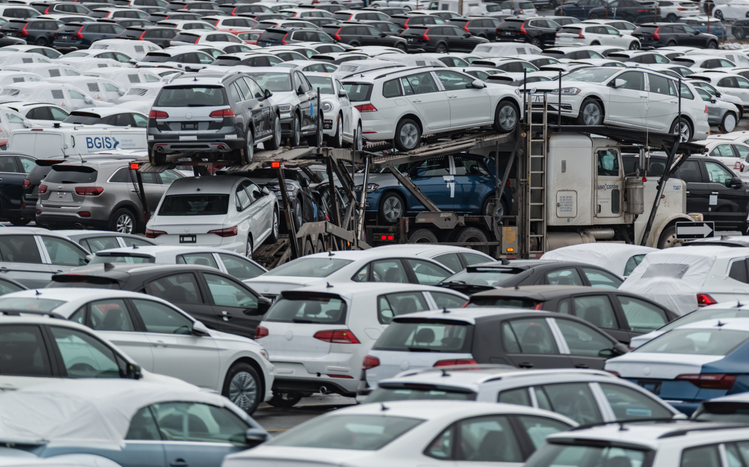Even before the noise around tariffs, the automotive industry has faced significant challenges in recent times. From semi-conductor shortages to workforce issues, strike action and EV policy identity crisis, there’s been no shortage of hurdles.

What do tariffs mean for the automotives industry?
Threats of tariffs have been hitting the sector from multiple angles. It is hard to keep up, but this is what we know so far.
Firstly, we had what I am calling the fentanyl-related tariffs, which were applied to goods imported from China, Mexico and Canada. Trump said the drug fentanyl being smuggled into the US was one of the reasons for putting tariffs on these countries. Specifically, a 25% tariff on imports from Canada and Mexico and a 10% tariff on imports from China would take effect on 4 February.
Secondly, specific tariffs on automotives have been announced.
There are a few different levels to this:
It is expected light passenger vehicles and trucks assembled in the US will have no tariffs on United States-Mexico-Canada Agreement (USMCA) parts for now.
Light vehicles and trucks which are assembled in Mexico or Canada and then shipped for sale in the US will not have to pay tariffs on the US-made parts if the vehicle qualifies for the USMCA, otherwise there will be a 25% tariff on entire vehicle content.
Light vehicles imported from outside of North America will be subject to a 25% tariff on the full value of the car. This includes the vehicle and its component parts. However, it is important to emphasise that the tariffs are levied on the transfer price not the Manufacturer’s Suggested Retail Price (MSRP).
Last, but certainly not least, there are the reciprocal tariffs – the ones placed on countries in response to actions by other countries – that were announced on “Liberation Day”. Most notably Cambodia was subjected to a 49% tariff, Vietnam 46%, Thailand 37%, and China 34%.
Since then, we’ve seen China hit back. This was followed by Trump’s announcement of a 90-day tariff pause on reciprocal tariffs and applying the 10% baseline tariff to all whilst hiking tariffs on China to 125%. On Thursday 11 April the White House clarified that total tariffs on China have reached 145%. These are turbulent times. Watch this space.
It has, however, been suggested that these reciprocal tariffs will not stack on top of the 25% automotive tariffs already applied to the transfer price of light vehicles, trucks and automotive parts. Trump has indicated that automotive manufacturers that have already announced new investment in the US are in a stronger position to bargain on automotive parts tariffs.
Who is impacted?
Essentially the whole sector. Companies are going to have to rewire at least some elements of their production.
The most obvious car companies to be impacted are General Motors, Ford and Stellantis, which produce vehicles in Mexico and Canada.
We believe, however, that the auto brands likely to be hardest hit are Porsche and Audi, due to their reliance on Europe for their production – therefore not benefitting from any relief from US exemptions for US-manufactured parts.
In addition, we believe lower-priced models that are imported into the US could become unfeasible. Mercedes has alluded to considering stopping the sale of the GLA model in the US.
Volkswagen has already announced that it will apply an “import fee” on cars affected by the 25% vehicle tariff. Volkswagen has also said it has temporarily halted rail shipments of vehicles from Mexico and would hold cars arriving by ship from Europe at port. The company told dealers it would give more details by mid-April on pricing strategies for tariff-affected cars and plans to begin allocating those vehicles to stores by the end of the month.
We are already starting to see updated guidance on margin being negatively impacted. Notably BMW commented that it saw potentially “low 3-digit million impact” for tariffs on China; “mid-three-digit million” from the 25% tariffs on Mexico/Canada; “high-double-digit million” from tariffs on steel and aluminium.
Based on the narrative we have seen from automotive manufacturers and suppliers, we expect to see some supply chain disruptions and production idling, which will not be positive – especially for suppliers where stop/start production and low production volumes can be very inefficient.
The longer-term impact on autos
Auto sales volumes in the US for the month of March came in strong at 17.8 million vs a forecast of 16.2 million. This is likely due to consumers’ expectation of higher prices in future due to tariffs. We can expect a fall in sales volumes in the coming months to balance the spike we saw in March.
In the medium to long term, Trump’s hope for boosting the number of US manufacturing jobs for skilled workers is likely to be challenged by the available capacity in US plants. Time will tell if significant capex for more US plants will be required or whether an inflationary trickle-down cost for consumers supresses appetites.
By threatening to impose equal or greater tariffs in retaliation, the US is forcing auto manufacturers to choose sides in a fragmented global market. The risk here is supply chain duplication, where companies must split between “East” and “West”, leading to inefficiencies as a result of lower utilisation, potential redundancies to allocate workforce elsewhere and higher capital expenditure.
What this means for where to invest
As I mentioned at the start of this article, the automotive sector has faced significant challenges over recent years, but we have still seen continued high levels of liquidity and healthy balance sheets overall.
However, these shifts are seismic for the sector, with increased costs, re-shifting of supply chains and suppliers, reductions in margins and potential knock-on impacts for demand for new cars if the broader economic sentiment deteriorates. Those car manufacturers with finance books could be further impacted by an increase in delinquencies on car loans impacting that side of their business too.
The sector is becoming harder to invest in, as we expect a deterioration in credit quality almost across the board (Renault, surprisingly, the standout). We focus on liquidity, refinancing needs, delinquency rates and those which are likely to be impacted the most from any of these changes to global trade.
Whilst this story continues to unfold with the potential of further retaliatory tariffs against the US and other bumps in the road, the value of stability has never been clearer. For those investors seeking calm in the storm, we believe fixed income strategies prove their worth with a focus on high levels of liquidity, low volatility and diverse portfolios of high-quality stable issuers.


